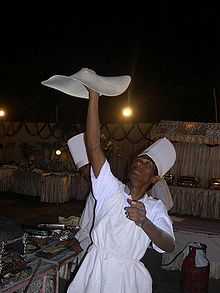
A chef preparing rumali roti.
Rumali Roti (Hindi: रूमाली रोटी; Urdu: رومالی روٹی) is a thin flatbread popular in South Asia. It is enjoyed with Tandoori dishes and as a traditional element in Mughlai cuisine. The word rumal means handkerchief in Urdu and Hindi, and the name rumali roti means handkerchief bread. The bread is extremely thin and supple, and the fact that it is usually served folded like a handkerchief are the probable sources of the name.[citation needed] During the Mughal period, the roti was used like a cloth to wipe off the excess oil off the hands after the completion of an oil-rich food laden with meat and fat. The rumali roti also occupied a unique place in the emblem of the royalty of Oudh under the control of Mughals.
The bread is usually made with a combination of whole and white wheat flours (atta and maida respectively) and best cooked on top of (on the convex side of) an inverted Indian griddle (kadhai).
|
|---|
| | | | Types | |
|---|
| | Ingredients | |
|---|
| | Equipment | |
|---|
| | Processes | |
|---|
| | Uses | |
|---|
| | Other | |
|---|
| |
|

